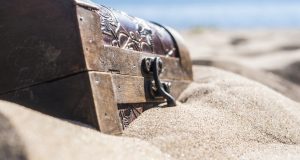
It was just after ten on a blustery Beaconsfield night, seven or eight days into the dramatic saga of the mining rescue, when a young man stepped tentatively into the little, red-brick Uniting Church.
I guessed he was a miner: a big, burley bloke with big hands to match his bulking frame.
He had a few tattoos, working boots and tiny wet sprinkles from the evening drizzle clung to his uncut hair. Beside him was his more petite female partner.
He was like a giant in a dolls house, almost threatening to step on the furniture.
Sheepishly they made their way in from the dark, pulling up a pew about halfway down to the front.
After a while they got up and gingerly stepped to the very front of the church – the communion rail – where a little tray burning candles flickered away in the night.
They each lit their own candle, put it on the tray with the others and made their way back to the safety of their pew. They sat close together.
As they looked blankly into space the gentle figure of Frances Seen, Uniting Church community minister, approached from behind. She softly put her arms out, placing a hand on the outer shoulder of each person and bending, whispered something to them.
Just then, his right hand climbed up over his chest and grabbed Frances’ hand and squeezed. A moment later he buckled over in tears.
Frances Seen had never met the couple before.
But 45 minutes later, after more tears, talking and some prayers they made their way back out into the night to face more of the prolonged wait for the rescue of Brant Webb and Todd Russell.
And surprising for me, an out of town observer, was just how often this one episode was repeated at Beaconsfield as this tough little mining town – and eventually Australia – watched, waited and prayed for rescue.
Frances Seen’s impulsive response to the news of an earthquake trapping some of the town’s sons a kilometre below the main street was to throw open the church doors, and invite people in to pray, to light a candle, to be safe when so much about them felt unsafe.
“All we are offering is what we have; a place that’s safe, warm and where they can say a prayer, light a candle and be comforted if that’s what they want,” she said.
Instead of doing what they always did, now was the time to respond — by being open and available morning and night.
When the body of Larry Knight was discovered more prayers were offered for the grieving, even as psychologically the community was preparing itself for more bad news.
The rescue teams were beginning to move from rescue to recovery phases, but Frances and her team had not given up hope.
“We are about the only ones keeping alive,” she remarked to one media outlet. The families of Brant Webb and Todd Russell appreciated that flicker of promise.
Even keeping hope alive did not stop once the two miners were found alive.
The little church became a 24 hour church.
One local said how encouraging it was simply to see lights glowing through the coloured windows of the church late into the night.
And it was never open without one of the church’s caring team present to offer a prayer, a hug or a warm cup of soup.
With the sudden death of celebrity journalist Richard Carlton the tension grew into confusion … people were asking ‘what on earth is going on here?’
Amid it all the Knight family waited to bury their son, husband, father.
So, the little church became a gathering point for reflection.
Situated just a nuggets throw from the mine, in the main street between the pub and the newsagent it was a dropping off point for solace and compassion. As Frances Seen reflected later: “We had the pews between the news and the booze!”
Soup, casseroles, homemade biscuits came in as expressions of care. This was then dished out to the extended ‘rescue’ community – including the media – complete with a cold beer if they wanted one.
Family members of the trapped miners came and sat, talked, prayed.
So did their rescuers and their wives and partners, interstate mining experts, media professionals, local politicians, townsfolk, tourists. Old miner’s lit candles remembering past ‘near misses’ and tragedies.
As news spread of this ministry of presence phone calls came in from around the world from families who had experienced similar tragedies and rescues.
Francis prayed with them on her little mobile phone across the seas.
When Frances and her crew dragged out the old church bell – not rung since sometime around the end of WWII – everyone knew just how special this event had become.
The ring of that bell echoed around the world – CNN carried it on both its USA domestic service and its international coverage.
The township was walking on air that morning but even then Frances Seen reminded the media that “we ring this bell as a sign of joy for our boys and a lament for Larry”.
As the pealing continued, inside the church was one of the rescuers wives – eyes wet with tears of joy. Just six hours earlier she had been in there so distraught that she was all most afraid to go home.
Frances Seen put it this way: “We have used up a lifetime of adrenalin here”. No wonder there were tears, fears and more than a few prayers from hardened miners, famous journalists and local townsfolk alike.
Or, as one man said, as he got out of his ute: “She a bloody remarkable saint that woman – they all are!”
Photo : Beaconsfield Community Minister Frances Seen
 JourneyOnline
JourneyOnline






